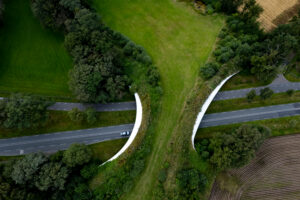14/06/2023

A large (12-16mm), distinctive, robust solitary bee with yellow marking down the side of their abdomen and on their legs.
They fly from May to August and at this time of year can be spotted in patches of flowers, most notably Lamb’s ear (Stachys byzantina) in parks and gardens.
They are named Wool carder bees because the female collects or ‘carders’ the soft downy hairs from the wooly leaves of Lamb’s ear, as well as Great Mullein (Verbascum) and Rose Campion (Silene coronaria), to line her nest.
She can be seen collecting a ball of the material under her abdomen and flying home with it. She nests in existing holes or cavities in dead wood, walls and manmade bee hotels. She divides up the nest into separate rooms, and provisions each room with pollen on which she lays an egg. She then seals the nest with nearby material such as dried leaves and mulch and leaves the larvae to emerge, eat the pollen and pupate into an adult bee.
The male bee, is unusually larger than the female. Like all male bees, they do not have a sting. But male Wool carder bees have sharp spikes at the end of their abdomen that they use to see off other bees from the patch of flowers they jealously guard for potential mates. Their fierce defence tactics can include head butting, wrestling and crushing a trespasser to death against their spikes.
This territorial behaviour can be observed from the comfort of a garden chair, if you plant a large clump of Lamb’s ear in your garden.
Athidium manicatum is native to Europe but has accidentally been transported across the world via nests in wood cavities and is thought to be the most widely distributed solitary bee. There are several hundred other species of wool carder bee worldwide.
Helping Wool Carder Bees
- Grow food and nesting material:
Female wool carder bees need fuzzy-leaved plants such as Lamb’ Ear, Great Mullein and Rose Campion to construct their nest. They feed mainly on Black horehound (a wild flower that we should start growing in our gardens), and legumes likes vetches and Bird’s foot trefoil, again not commonly grown in gardens.
- Leave dead wood:
They nest in pre-existing holes that may have been excavated by beetles.
- Install a bee hotel with some 10mm diameter tubes:
They have been known to check into manmade bee hotels from June to August.
For other bees to see this month, how to tell them apart and how to help them sign up to Alison’s Buzz newsletter
Words: Alison Benjamin, Urban Bees

